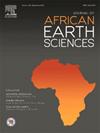Chellata strike-slip fault a transkabyle polyphase fault, contemporary with the Miocene collision (Kabylian “Dorsal”, Algeria): A new kinematic and geodynamic interpretation
IF 2.2
4区 地球科学
Q2 GEOSCIENCES, MULTIDISCIPLINARY
引用次数: 0
Abstract
The Rif, Kabyle, and Sicilian-Calabrian fronts are primarily manifested by thrust structures on the forelands of African origin. These thrust fronts of the internal zones over the external zones of the Maghreb exhibit variable geometries depending on the transects: the average dip differs from one block to another, as seen between the Djurdjura and Chellata massifs, located on either side of the eponymous pass. The differential tangential block displacement between these two entities creates a decoupling through a strike-slip system, making them relatively autonomous. The Chellata massif retains a coherent paleogeographic organization, while the western Djurdjura shows moderate deformation and thick formations. To the east, deformation gradually decreases, waning near the Chellata massif and concentrating at the Chellata Pass fault. This structure, interpreted in this paper as a sinistral strike-slip, challenges earlier interpretations by Gélard in his thesis, which suggested a dextral motion. The structural analysis reveals two main phases of sliding between the Djurdjura and Chellata blocks. The first phase, sinistral, displaces the Djurdjura by 15–20 km to the south. The second phase, dextral, brings the Chellata block back to its current position. This dynamic is facilitated by a network of conjugate strike-slip faults, notably the Chellata fault to the east and the Thénia-Bouira fault to the west. This phase of late strike-slip and thrusting, dated between the Serravallien-Tortonien is part of the Maghreb collision, synchronized with oceanic opening in the western Mediterranean and the activity of the south Mediterranean transform network.
与中新世碰撞(阿尔及利亚卡比连“背侧”)同时代的跨卡比勒多相断层切拉塔走滑断层:一种新的运动学和地球动力学解释
裂谷、卡比尔和西西里-卡拉布里亚锋面主要表现为非洲起源的前陆上的冲断构造。马格里布内部区域的冲断锋面在外部区域上表现出不同的几何形状,这取决于横断面:平均倾角不同于另一个区块,如位于同名通道两侧的Djurdjura和Chellata地块之间所见。这两个实体之间的切向块位移通过走滑系统产生解耦,使它们相对独立。切拉塔地块保持了连贯的古地理组织,而大jurdjura西部则表现出中度变形和厚地层。向东,变形逐渐减小,在切拉塔地块附近减弱,在切拉塔山口断裂处集中。这种结构在论文中被解释为左旋走滑,挑战了格姆拉德在他的论文中提出的右旋运动的早期解释。构造分析揭示了Djurdjura块体和Chellata块体之间的两个主要滑动阶段。第一阶段,西北风,使Djurdjura向南移动了15-20公里。第二阶段,右旋,使切拉塔块回到当前位置。这种动态是由共轭走滑断层网络促成的,特别是东部的切拉塔断层和西部的萨姆尼亚-布伊拉断层。在Serravallien-Tortonien之间的这一晚期走滑和逆冲阶段是马格里布碰撞的一部分,与西地中海的海洋张开和南地中海转换网的活动同步。
本文章由计算机程序翻译,如有差异,请以英文原文为准。
求助全文
约1分钟内获得全文
求助全文
来源期刊

Journal of African Earth Sciences
地学-地球科学综合
CiteScore
4.70
自引率
4.30%
发文量
240
审稿时长
12 months
期刊介绍:
The Journal of African Earth Sciences sees itself as the prime geological journal for all aspects of the Earth Sciences about the African plate. Papers dealing with peripheral areas are welcome if they demonstrate a tight link with Africa.
The Journal publishes high quality, peer-reviewed scientific papers. It is devoted primarily to research papers but short communications relating to new developments of broad interest, reviews and book reviews will also be considered. Papers must have international appeal and should present work of more regional than local significance and dealing with well identified and justified scientific questions. Specialised technical papers, analytical or exploration reports must be avoided. Papers on applied geology should preferably be linked to such core disciplines and must be addressed to a more general geoscientific audience.
 求助内容:
求助内容: 应助结果提醒方式:
应助结果提醒方式:


